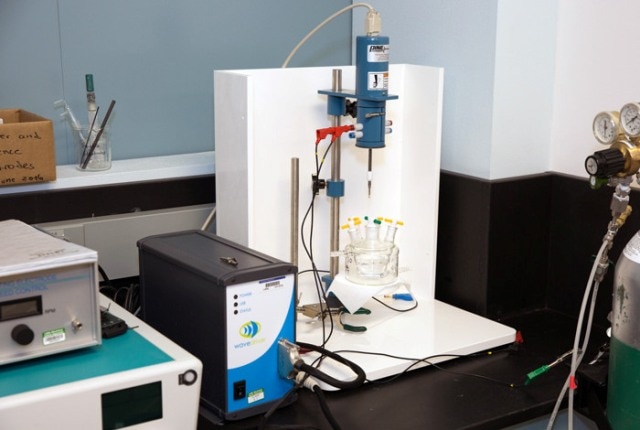Jun 14 2016
The 2015 movie “The Martian” shows how a stranded astronaut, Matt Damon, attempts to create lifesaving water using the chemistry of rocket fuel, hydrogen and hydrazine, and almost blows himself up. However, if the process is turned around with the help of hydrazine, hydrogen can be produced from water by simply altering the semiconductor’s conductivity. This breakthrough has great potential for electronics and energy applications.
 New research from Los Alamos National Laboratory researchers, “Efficient Hydrogen Evolution in Transition Metal Dichalcogenides via a Simple One-Step Hydrazine Reaction,” not only presents one of the best hydrogen water splitting electrocatalysts to date, but also opens up a whole new direction for research in electrochemistry and semiconductor device physics. (Credit: Los Alamos National Laboratory)
New research from Los Alamos National Laboratory researchers, “Efficient Hydrogen Evolution in Transition Metal Dichalcogenides via a Simple One-Step Hydrazine Reaction,” not only presents one of the best hydrogen water splitting electrocatalysts to date, but also opens up a whole new direction for research in electrochemistry and semiconductor device physics. (Credit: Los Alamos National Laboratory)
“We demonstrate in our study that a simple chemical treatment, in this case a drop of dilute hydrazine (N2H4) in water, can dope electrons directly to a semiconductor, creating one of the best hydrogen-evolution electrocatalysts,” said Gautam Gupta, project leader at Los Alamos National Laboratory in the Light to Energy team of the Lab’s Materials Synthesis and Integrated Devices group. The study was published in the journal, “Nature Communications.”
Knowing how to apply an easy-to-use, room-temperature treatment to radically modify the material properties could revolutionize electronic applications and renewable energy production. As part of it's mission, Los Alamos National Laboratory performs multidisciplinary research to bolster the nation’s energy security, including exploration of alternative energy sources.
Recently, materials science researchers have become more interested in the catalytic and electrical properties of layered transition metal dichalcogenides (TMDs). These TMDs mainly constitute metal sulfides and selenides (e.g., MoS2) with a layered structure like graphite, and this layered structure takes into account the opportunities and challenges while changing electrical properties and functionality.
Gupta and Aditya Mohite, a physicist holding a doctorate in electrical engineering, have been leading the research at Los Alamos to figure out TMDs’ electrical properties and utilize the understanding to enhance these semiconductors for renewable energy production.
In their work, the researchers tested a MoS2 shell - MoOx core nanowires, pure MoS2 particles and 2D sheets – for electrocatalysis of the hydrogen development reaction. It was observed that when dilute hydrazine was added to MoS2 the performance of the electrocatalytic process improved considerably. Further testing revealed that the MoS2 transforms from having semiconducting behavior to more metallic properties after exposure to hydrazine.
The most interesting thing about this result is that it is different than conventional doping, where actual chemicals are added to a semiconductor to change its charge carrier concentration. In the case of hydrazine treatment, we are ‘doping’ electrons directly to the material, without modifying the original chemistry.
Dustin Cummins, Postdoctoral Researcher, Los Alamos National Laboratory
Cummins initially identified the hydrogen-production result while working along with Gupta at Los Alamos as a graduate student research partner from the University of Louisville (advisor: Dr. Mahendra Sunkara) and he went on to carry out experiments and upgrade discussion while working as a postdoctoral scholar.
Hydrazine acting as an electron dopant in inorganic semiconductors has been observed since the 1970s, but there is limited understanding of the process. Our biggest hurdle was to prove to that hydrazine was actually changing the conductivity of the MoS2 system, and that is what results in increased catalytic activity.
Dustin Cummins, Postdoctoral Researcher, Los Alamos National Laboratory
Los Alamos staff from different areas of expertise in chemistry, layered semiconductors, electrical device fabrication and spectroscopy, collaborated to present some of the most excellent method and perceptive for hydrazine that acts as an electron dopant.
This research paper, “Efficient Hydrogen Evolution in Transition Metal Dichalcogenides via a Simple One-Step Hydrazine Reaction,” reveals one of the best hydrogen water splitting electrocatalysts till date and “it opens up a whole new direction for research in electrochemistry and semiconductor device physics in general,” said Gupta.